Ground-Mounted Photovoltaic and Crop Cultivation: A Comparative Analysis
Abstract
:1. Introduction
- The analysis of climate conditions;
- The economic efficiency of the PV projects;
- The economic indicators of the crop production and their comparison with the PV projects;
- The reduction of carbon dioxide emission for the PV projects.
- The results will be useful to develop a strategy for the regional division of labor.
2. Materials and Methods
2.1. Data Collection
2.2. Net Present Value and Profitability Index for Crop Cultivation Projects
2.3. Coefficient of Variation
2.4. R.Green.Solar Model
- Solar radiation;
- Digital Terrain Model (DTM);
- Land use and main roads;
- Boundaries.
2.5. Economic Indicator of a PV Plant
2.6. Carbon Dioxide Emissions
3. Results and Discussion
3.1. Climate Conditions and the Status of Agriculture
3.2. Economic Indicators of PV Projects
3.3. Economic Indicators of Crop Cultivation Projects
3.4. The Reduction of Carbon Dioxide Emission
4. Conclusions
Author Contributions
Funding
Conflicts of Interest
References
- Hilgedieck, J.; Magdowski, A.; Christ, D.; Janczik, S.; Witt, J.; Kaltschmitt, M. Erneuerbare Energien Weltweit: Globaler Stand 2018. BWK Das Energ. Fachmag. 2019, 71, 18–40. Available online: http://hdl.handle.net/11420/4581 (accessed on 23 March 2022).
- Report of the Conference of the Parties on Its Twenty-First Session, Held in Paris from 30 November to 13 December 2015. 2016. Available online: https://unfccc.int/resource/docs/2015/cop21/eng/10.pdf (accessed on 23 March 2022).
- EC Clean Energy for All Europeans. Available online: https://op.europa.eu/en/publication-detail/-/publication/b4e46873-7528-11e9-9f05-01aa75ed71a1/language-en (accessed on 8 April 2022).
- IRENA. Renewable Energy Capacity Statistics 2020; International Renewable Energy Agency: Abu Dhabi, United Arab Emirates, 2020; Available online: https://irena.org/-/media/Files/IRENA/Agency/Publication/2020/Mar/IRENA_RE_Capacity_Statistics_2020.pdf (accessed on 1 May 2022).
- International Renewable Energy Agency (IRENA). Renewable Energy Statistics. July 2019. Available online: https://webstore.iea.org/key-world-energy-statistics-2019 (accessed on 8 May 2022).
- Blankenship, R.; Tiede, D.; Barber, J.; Brudvig, G.W.; Fleming, G.; Ghirardi, M.; Gunner, M.; Junge, W.; Kramer, D.; Melis, A.; et al. Comparing photosynthetic and photovoltaic efficiencies and recognizing the potential for improvement. Science 2011, 332, 805–809. [Google Scholar] [CrossRef] [PubMed] [Green Version]
- Fraunhofer ISE. Current and future cost of photovoltaics. In Longterm Scenarios for Market Development, System Prices and LCOE of Utility-Scale PV Systems; Agora Energiewende: Berlin, Germany, 2015; Available online: https://www.ise.fraunhofer.de/content/dam/ise/de/documents/publications/studies/AgoraEnergiewende_Current_and_Future_Cost_of_PV_Feb2015_web.pdf (accessed on 2 May 2022).
- Weselek, A.; Ehmann, A.; Zikeli, S.; Lewandowski, I.; Schindele, S.; Högy, P. Agrophotovoltaic systems: Applications, challenges, and opportunities. A review. Agron. Sustain. Dev. 2019, 39, 35. [Google Scholar] [CrossRef]
- WTRG Economics. Available online: https://wtrg.com/ (accessed on 3 April 2022).
- EU Natural Gas. Available online: https://tradingeconomics.com/commodity/eu-natural-gas (accessed on 3 April 2022).
- Wholesale Prices of Electricity in Poland from 2018 to 2022 (in Zloty/MWh). Available online: https://www.statista.com/statistics/1066654/poland-wholesale-electricity-prices/ (accessed on 20 May 2022).
- Polish Zloty to Euro Spot Exchange Rates for 2021. Available online: https://www.exchangerates.org.uk/PLN-EUR-spot-exchange-rates-history-2021.html (accessed on 20 May 2022).
- Average Monthly Electricity Wholesale Prices in Selected Countries in the European Union (EU) from January 2020 to January 2022. Available online: https://www.statista.com/statistics/1267500/eu-monthly-wholesale-electricity-price-country/ (accessed on 15 March 2022).
- Purchase Prices on the Day-Ahead Market for Group b Consumers in 2021. Available online: https://tek.energy/electricity/prices (accessed on 20 December 2021).
- Tidey, A. Brussels Agrees to ‘Iberian Exception’ Allowing Spain and Portugal to Cap Electricity Prices. Available online: https://www.euronews.com/my-europe/2022/04/26/brussels-agrees-to-iberian-exception-allowing-spain-and-portugal-to-cap-electricity-prices (accessed on 1 July 2022).
- Electricity Prices for Non-Household Consumers. Available online: https://ec.europa.eu/eurostat/statistics-explained/index.php?title=Electricity_price_statistics#Electricity_prices_for_non-household_consumers (accessed on 20 December 2021).
- Hosseini, S.E. An Outlook on the Global Development of Renewable and Sustainable Energy at the Time of COVID-19. Energy Res. Soc. Sci. 2020, 68, 101633. [Google Scholar] [CrossRef]
- How Europe’s Reliance on Russia’s Gas Plays into the War in Ukraine. Available online: https://www.npr.org/2022/02/09/1079338002/russia-ukraine-europe-gas-nordstream2-energy (accessed on 28 March 2022).
- Will Europe Have to Return to Coal if Russia Cuts Off Gas Imports? Available online: https://www.euronews.com/green/2022/03/07/europe-scrambles-to-keep-the-lights-on-as-it-sidelines-russian-gas (accessed on 30 April 2022).
- Hosseini, S.E. Transition Away from Fossil Fuels toward Renewables: Lessons from Russia-Ukraine Crisis. Future Energy 2022, 1, 2–5. Available online: https://fupubco.com/fuen/article/view/8 (accessed on 30 April 2022). [CrossRef]
- Scientific American: Science News, Expert Analysis, Health Research—Scientific American. Available online: https://www.scientificamerican.com/ (accessed on 30 April 2022).
- Brauers, H.; Oei, P.Y. The political economy of coal in Poland: Drivers and barriers for a shift away from fossil fuels. Energy Policy 2020, 144, 111621. [Google Scholar] [CrossRef]
- Energy Market Agency. Available online: https://www.are.waw.pl/ (accessed on 1 May 2022).
- Rataj, M.; Berniak-Woźny, J.; Plebańska, M. Poland as the EU Leader in Terms of Photovoltaic Market Growth Dynamics—Behind the Scenes. Energies 2021, 14, 6987. [Google Scholar] [CrossRef]
- Bilan, Y.; Nitsenko, V.; Havrysh, V. Energy Aspect of Vertical Integration in Agriculture. Rynek Energii 2017, 5, 98–110. Available online: http://dspace.onu.edu.ua:8080/bitstream/123456789/11761/1/98-110.pdf (accessed on 30 April 2022).
- Havrysh, V.; Kalinichenko, A.; Mentel, G.; Olejarz, T. Commercial Biogas Plants: Lessons for Ukraine. Energies 2020, 13, 2668. [Google Scholar] [CrossRef]
- BP Statistical Review of World Energy. 2021. Available online: https://www.bp.com/content/dam/bp/business-sites/en/global/corporate/pdfs/energy-economics/statistical-review/bp-stats-review-2021-full-report.pdf (accessed on 26 May 2022).
- IRENA. Energy Profile of Ukraine. 2021. Available online: https://www.irena.org/IRENADocuments/Statistical_Profiles/Europe/Ukraine_Europe_RE_SP.pdf (accessed on 26 May 2022).
- Havrysh, V.; Kalinichenko, A.; Szafranek, E.; Hruban, V. Agricultural Land: Crop Production or Photovoltaic Power Plants. Sustainability 2022, 14, 5099. [Google Scholar] [CrossRef]
- Bigorajski, J.; Chwieduk, D. Analysis of a micro photovoltaic/thermal—PV/T system operation in moderate climate. Renew. Energy 2019, 137, 127–136. [Google Scholar] [CrossRef]
- Kruzel, R.; Helbrych, P. Analysis of the profitability of a photovoltaic installation in the context of sustainable development of construction. E3S Web Conf. 2021, 49, 00061. [Google Scholar] [CrossRef] [Green Version]
- Fast, S. Social acceptance of renewable energy: Trends, concepts, and geographies: Social acceptance of renewable energy. Geogr. Compass 2013, 7, 853–866. [Google Scholar] [CrossRef]
- Upham, P.; Oltra, C.; Boso, À. Towards a cross-paradigmatic framework of the social acceptance of energy systems. Energy Res. Soc. Sci. 2015, 8, 100–112. [Google Scholar] [CrossRef]
- Schmidt, T.S. Low-carbon investment risks and de-risking. Nat. Clim. Chang. 2014, 4, 237–239. [Google Scholar] [CrossRef]
- DECC (Department of Energy and Climate Change). Statement on Ending Subsidies for Onshore Wind. 2015. Available online: https://www.gov.uk/government/speeches/statement-onending-subsidies-for-onshore-wind. (accessed on 9 July 2022).
- Wüstenhagen, R.; Wolsink, M.; Bürer, M.J. Social acceptance of renewable energy innovation: An introduction to the concept. Energy Policy 2007, 35, 2683–2691. [Google Scholar] [CrossRef] [Green Version]
- Roddis, P.; Carver, S.; Dallimer, M.; Norman, P.; Ziv, G. The role of community acceptance in planning outcomes for onshore wind and solar farms: An energy justice analysis. Appl. Energy 2018, 226, 353–364. [Google Scholar] [CrossRef]
- IRENA. Solar Energy. Available online: https://www.irena.org/solar (accessed on 1 May 2022).
- Gulaliyev, M.G.; Mustafayev, E.R.; Mehdiyeva, G.Y. Assessment of Solar Energy Potential and Its Ecological-Economic Efficiency: Azerbaijan Case. Sustainability 2020, 12, 1116. [Google Scholar] [CrossRef] [Green Version]
- Kulpa, J.; Olczak, P.; Surma, T.; Matuszewska, D. Comparison of Support Programs for the Development of Photovoltaics in Poland: My Electricity Program and the RES Auction System. Energies 2022, 15, 121. [Google Scholar] [CrossRef]
- Hagspiel, V.; Nunes, C.; Oliveira, C.; Portela, M. Green investment under time-dependent subsidy retraction risk. J. Econ. Dyn. Control 2020, 3936, 103936. [Google Scholar] [CrossRef]
- Sendstad, L.H.; Hagspiel, V.; Mikkelsen, W.J.; Ravndal, R.; Tveitstøl, M. The impact of subsidy retraction on European renewable energy investments. Energy Policy 2022, 160, 112675. [Google Scholar] [CrossRef]
- Dong, C.; Zhou, R.; Li, J. Rushing for subsidies: The impact of feed-in tariffs on solar photovoltaic capacity development in China. Appl. Energy 2021, 281, 116007. [Google Scholar] [CrossRef]
- Ameli, N.; Brandt, N. Determinants of households’ investment in energy efficiency and renewables: Evidence from the OECD survey on household environmental behaviour and attitudes. Environ. Res. Lett. 2015, 10, 044015. [Google Scholar] [CrossRef]
- Niamir, L.; Ivanova, O.; Filatova, T.; Voinov, A.; Bressers, H. Demand-side solutions for climate mitigation: Bottom-up drivers ofhousehold energy behavior change in the Netherlands and Spain. Energy Res. Soc. Sci. 2020, 62, 101356. [Google Scholar] [CrossRef]
- Bielski, S.; Marks-Bielska, R.; Zielińska-Chmielewska, A.; Romaneckas, K.; Šarauskis, E. Importance of Agriculture in Creating Energy Security—A Case Study of Poland. Energies 2021, 14, 2465. [Google Scholar] [CrossRef]
- BP. Statistical Review of World Energy, 68th ed.; BP: London, UK, 2019; Available online: https://www.bp.com/content/dam/bp/businesssites/en/global/corporate/pdfs/energy-economics/statistical-review/bp-stats-review-2019-full-report.pdf (accessed on 12 May 2022).
- Brodziński, Z.; Brodzińska, K.; Szadziun, M. Photovoltaic Farms—Economic Efficiency of Investments in North-East Poland. Energies 2021, 14, 2087. [Google Scholar] [CrossRef]
- Dias, L.; Gouveia, J.P.; Lourenço, P.; Seixas, J. Interplay between the potential of photovoltaic systems and agricultural land use. Land Use Policy 2019, 81, 725–735. [Google Scholar] [CrossRef]
- Majumdar, D.; Pasqualetti, M.J. Analysis of land availability for utility-scale power plants and assessment of solar photovoltaic development in the state of Arizona, USA. Renew. Energy 2019, 134, 1213–1231. [Google Scholar] [CrossRef]
- Calvert, K.; Mabee, W. More solar farms or more bioenergy crops? Mapping and assessing potential land-use conflicts among renewable energy technologies in eastern Ontario, Canada. Appl. Geogr. 2015, 56, 209–221. [Google Scholar] [CrossRef]
- Marques-Perez, I.; Guaita-Pradas, I.; Gallego, A.; Segura, B. Territorial planning for photovoltaic power plants using an outranking approach and GIS. J. Clean. Prod. 2020, 257, 120602. [Google Scholar] [CrossRef]
- Tercan, E.; Eymen, A.; Urfali, T.; Saracoglu, B.O. A sustainable framework for spatial planning of photovoltaic solar farms using GIS and multi-criteria assessment approach in Central Anatolia, Turkey. Land Use Policy 2021, 102, 105272. [Google Scholar] [CrossRef]
- Sacchelli, S.; Garegnani, G.; Geri, F.; Grilli, G.; Paletto, A.; Zambelli, P.; Ciolli, M.; Vettorato, D. Trade-off between photovoltaic systems installation and agricultural practices on arable lands: An environmental and socio-economic impact analysis for Italy. Land Use Policy 2016, 56, 90–99. [Google Scholar] [CrossRef] [Green Version]
- Statistical Yearbook of Agriculture. Warsaw 2021. Available online: https://stat.gov.pl/en/topics/statistical-yearbooks/statistical-yearbooks/statistical-yearbook-of-agriculture-2021,6,16.html (accessed on 5 May 2022).
- Energy Statistics in 2019 and 2020. Warsaw 2021. Available online: https://stat.gov.pl/en/topics/environment-energy/energy/ (accessed on 5 May 2022).
- Plant Growing in Ukraine 2020; State Statistics Service of Ukraine: Kyiv, Ukraine, 2021; Available online: http://www.ukrstat.gov.ua/druk/publicat/kat_u/2021/zb/05/zb_rosl_2020.pdf (accessed on 17 April 2022).
- Curtis, T.; Heath, G.; Walker, A.; Desai, J.; Settle, E.; Barbosa, C. Best Practices at the End of the Photovoltaic System Performance Period; Technical Report NREL/TP-5C00-78678; National Renewable Energy Laboratory (NREL): Golden, CO, USA, 2021; Available online: https://www.nrel.gov/docs/fy21osti/78678.pdf (accessed on 7 May 2022).
- United States Department of Agriculture, Foreign Agricultural Service. Grain and Feed Annual. Ukraine; Report Number: UP2021-0017; United States Department of Agriculture, Foreign Agricultural Service: Washington, DC, USA, 2021. Available online: https://apps.fas.EURa.gov/newgainapi/api/Report/DownloadReportByFileName?fileName=Grain%20and%20Feed%20Annual_Kyiv_Ukraine_04-15-2021 (accessed on 15 March 2022).
- United States Department of Agriculture, Foreign Agricultural Service. Oilseeds and Products Annual. Ukraine; Report Number: UP2021-0016; United States Department of Agriculture, Foreign Agricultural Service: Washington, DC, USA, 2021. Available online: https://apps.fas.EURa.gov/newgainapi/api/Report/DownloadReportByFileName?fileName=Oilseeds%20and%20Products%20Annual_Kyiv_Ukraine_04-15-2021 (accessed on 15 March 2022).
- Comparison of Lifecycle Greenhouse Gas Emissions of Various Electricity Generation Sources. World Nuclear Association Report. July 2011. Available online: http://www.world-nuclear.org/uploadedFiles/org/WNA/Publications/Working_Group_Reports/comparison_of_lifecycle.pdf (accessed on 29 April 2022).
- Monthly and Annual Precipitation in Nikolaev. 2021. Available online: http://www.pogodaiklimat.ru/history/33846_2.htm (accessed on 5 May 2022).
- Climate OPOLE. Available online: https://en.tutiempo.net/climate/ws-125300.html (accessed on 5 May 2022).
- Agrotender. Available online: https://agrotender.com.ua/traders/region_ukraine/yachmen (accessed on 15 April 2022).
- Equator of the Grain Season-2019/20 in Ukraine: Success & Challenges. Available online: https://www.apk-inform.com/ru/exclusive/topic/1507460 (accessed on 15 April 2022).
- Ukraine: Average Demand Prices for Grains and Oilseeds (13 June–20 June 2019). Available online: https://www.apk-inform.com/ru/news/price/1500863 (accessed on 29 April 2022).
- Costs of Agricultural Production in Enterprises in 2020. Available online: http://www.ukrstat.gov.ua/operativ/operativ2018/sg/vytr_na%20ver_sg_prod/arch_vytr_na%20ver_sg_prod_u.htm (accessed on 29 May 2022).
- Šúri, M.; Huld, T.A.; Dunlop, E.D.; Ossenbrink, H.A. Potential of solar electricity generation in the European Union member states and candidate countries. Sol. Energy 2007, 81, 1295–1305. [Google Scholar] [CrossRef]
- Huld, T.; Müller, R.; Gambardella, A. A new solar radiation database for estimating PV performance in Europe and Africa. Sol. Energy 2012, 86, 1803–1815. [Google Scholar] [CrossRef]
- Copernicus Land Monitoring Service at a Glance. Available online: https://land.copernicus.eu/ (accessed on 7 May 2022).
- Europe. Available online: https://download.geofabrik.de/europe.html (accessed on 7 May 2022).
- Karaveli, A.B.; Soytas, U.; Akinoglu, B.G. Comparison of large scale solar PV (photovoltaic) and nuclear power plant investments in an emerging market. Energy 2015, 84, 656–665. [Google Scholar] [CrossRef]
- Bedin, D.; Holland, E.; Chies, A.; Annunziata, V.; Virdis, A. PVS in BLOOM: Business Guide—Ground Photovoltaic Investments on Marginal Areas. Intelligent Energy Europe Programme. 2011. Available online: https://ru.scribd.com/document/238261741/Business-Guide-Power-Sun (accessed on 7 May 2022).
- Havrysh, V.; Kalinichenko, A.; Mentel, G.; Mentel, U.; Vasbieva, D.G. Husk Energy Supply Systems for Sunflower Oil Mills. Energies 2020, 13, 361. [Google Scholar] [CrossRef] [Green Version]
- Havrysh, V.; Hruban, V.; Sadovoy, O.; Kalinichenko, A.; Taikhrib, K. Sustainable Energy Supply Based on Sunflower Seed Husk for Oil Mills. In Proceedings of the International Conference on Modern Electrical and Energy Systems (MEES), Kremenchuk, Ukraine, 23–25 September 2019. [Google Scholar] [CrossRef]
- Hammad, M.; Ebaid, M.S.Y. Comparative economic viability and environmental impact of PV, diesel and grid systems for large underground water pumping application (55 wells) in Jordan. Renewables 2015, 2, 12. [Google Scholar] [CrossRef] [Green Version]
- Wskaźniki Emisyjności CO2, SO2, NOx, CO i Pyłu Całkowitego Dla Energii Elektrycznej na Podstawie Informacji Zawartych w Krajowej Bazie o Emisjach Gazów Cieplarnianych i Innych Substancji za 2019 Rok. 2020. Available online: https://www.kobize.pl/uploads/materialy/materialy_do_pobrania/wskazniki_emisyjnosci/Wskazniki_emisyjnosci_grudzien_2020.pdf (accessed on 1 June 2022).
- Krawczak, E. Studies on PV power plant designing to fulfil the energy demand of small community in Poland. E3S Web Conf. 2019, 116, 00040. [Google Scholar] [CrossRef]
- Farja, Y.; Maciejczak, M. Economic Implications of Agricultural Land Conversion to Solar Power Production. Energies 2021, 14, 6063. [Google Scholar] [CrossRef]
- Warner, E.S.; Heath, G.A. Life Cycle Greenhouse Gas Emissions of Nuclear Electricity Generation. J. Ind. Ecol. 2012, 16 (Suppl. 1), 73–92. [Google Scholar] [CrossRef]
- Kadiyala, A.; Kommalapati, R.; Huque, Z. Evaluation of the Life Cycle Greenhouse Gas Emissions from Hydroelectricity Generation Systems. Sustainability 2016, 8, 539. [Google Scholar] [CrossRef] [Green Version]
- Shlapak, M. Carbon Emission Factor for Ukrainian Electricity Grid. 2017. Available online: https://www.linkedin.com/pulse/carbon-emission-factor-ukrainian-electricity-grid-mykola-shlapak/?articleId=6324279390976962560 (accessed on 29 April 2022).
- Roth, M.B.; Jaramillo, P. Going nuclear for climate mitigation: An analysis of the cost effectiveness of preserving existing U.S. nuclear power plants as a carbon avoidance strategy. Energy 2017, 131, 67–77. [Google Scholar] [CrossRef]
- Raadal, H.L.; Gagnon, L.; Modahl, I.S.; Hanssen, O.J. Life cycle greenhouse gas (GHG) emissions from the generation of wind and hydro power. Renew. Sustain. Energy Rev. 2011, 15, 3417–3422. [Google Scholar] [CrossRef]
- In 2020, the Installed Capacity of WPPs and SPPs Increased by 41% and Their Share in the Generation Mix Doubled. Ukrenergo. Available online: https://ua.energy/general-news/in-2020-the-installed-capacity-of-wpps-and-spps-increased-by-41-and-their-share-in-the-generation-mix-doubled/ (accessed on 29 April 2022).
- Moro, A.; Lonza, L. Electricity carbon intensity in European Member States: Impacts on GHG emissions of electric vehicles. Transp. Res. Part D 2018, 64, 5–14. [Google Scholar] [CrossRef]
- Agriculture of Ukraine. Statistical Yearbook. 2020; Agriculture of Ukraine: Kyiv, Ukraine, 2021. Available online: http://www.ukrstat.gov.ua/druk/publicat/kat_u/2019/zb/09/Zb_sg_2020.pdf (accessed on 15 May 2022).
- Crop Production of Ukraine 2019. Statistical Yearbook. Kyiv 2020. Available online: http://www.ukrstat.gov.ua/druk/publicat/kat_u/2020/zb/04/zb_rosl_2019.pdf (accessed on 15 May 2022).
- Durczak, K. Reliability of Agricultural Tractors According to Polish Farmers. Teh. Vjesn. 2020, 27, 1761–1766. [Google Scholar] [CrossRef]
- Lorencowicz, E.; Uziak, J. Regional structure of tractor market in Poland. Agric. Eng. 2020, 24, 51–62. [Google Scholar] [CrossRef]
- Hou, G.; Sun, H.; Jiang, Z.; Pan, Z.; Wang, Y.; Zhang, X.; Zhao, Y.; Yao, Q. Life cycle assessment of grid-connected photovoltaic power generation from crystalline silicon solar modules in China. Appl. Energy 2016, 164, 882–890. [Google Scholar] [CrossRef]
- Holka, M.; Bieńkowski, J. Carbon Footprint and Life-Cycle Costs of Maize Production in Conventional and Non-Inversion Tillage Systems. Agronomy 2020, 10, 1877. [Google Scholar] [CrossRef]
- O’Neill, M.; Lanigan, G.J.; Forristal, P.D.; Osborne, B.A. Greenhouse Gas Emissions and Crop Yields From Winter Oilseed Rape Cropping Systems are Unaffected by Management Practices. Front. Environ. Sci. 2021, 9, 716636. [Google Scholar] [CrossRef]
- Debaeke, P.; Casadebaig, P.; Flenet, F.; Langlade, N. Sunflower crop and climate change: Vulnerability, adaptation, and mitigation potential from case-studies in Europe. OCL 2017, 24, D102. [Google Scholar] [CrossRef] [Green Version]
- Rajaniemi, M.; Mikkola, H.J.; Ahokas, J. Greenhouse Gas Emissions from Oats, Barley, Wheat and Rye Production. Agron. Res. 2011, 9, 189–194. [Google Scholar]
- Gan, Y.; Liang, C.; Chai, Q.; Lemke, R.L.; Campbell, C.A.; Zentner, R.P. Improving farming practices reduces the carbon footprint of spring wheat production. Nat. Commun. 2014, 5, 5012. [Google Scholar] [CrossRef] [PubMed] [Green Version]
- Gan, Y.; Liang, C.; May, W.E.; Malhi, S.S.; Niu, J.; Wang, X. Carbon footprint of spring barley in relation to preceding oilseeds and N fertilization. Int. J. Life Cycle Assess. 2012, 17, 635–645. [Google Scholar] [CrossRef]
- Sustainable Development Goals. Available online: https://www.unodc.org/roseap/en/sustainable-development-goals.html (accessed on 10 July 2022).
- Al Mamun, M.A.; Dargusch, P.; Wadley, D.; Zulkarnain, N.A.; Aziz, A.A. A review of research on agrivoltaic systems. Renew. Sustain. Energy Rev. 2022, 161, 112351. [Google Scholar] [CrossRef]
- Valle, B.; Simonneau, T.; Sourd, F.; Pechier, P.; Hamard, P.; Frisson, T.; Ryckewaert, M.; Christophe, A. Increasing the total productivity of a land by combining mobile photovoltaic panels and food crops. Appl. Energy 2017, 206, 1495–1507. [Google Scholar] [CrossRef]
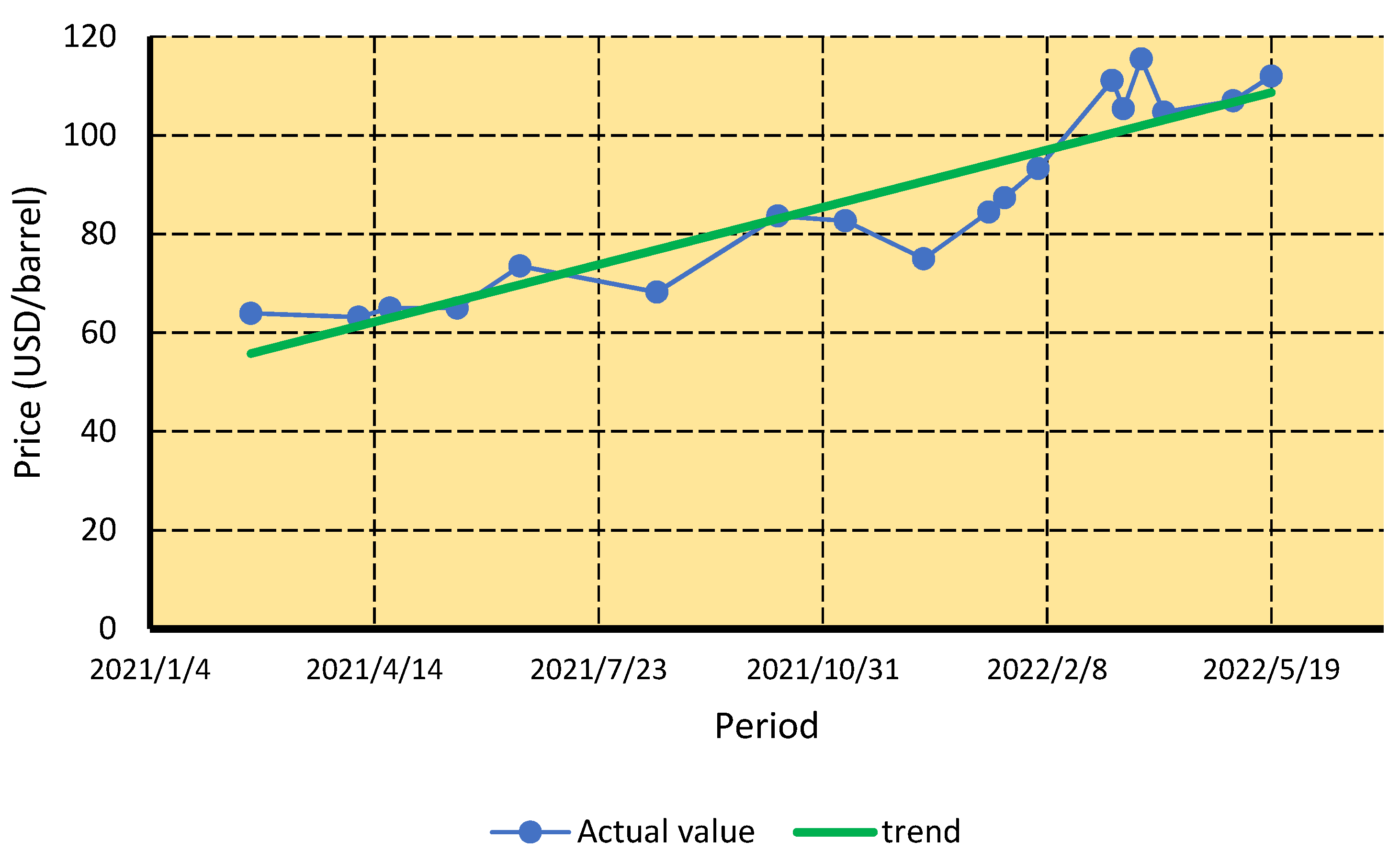
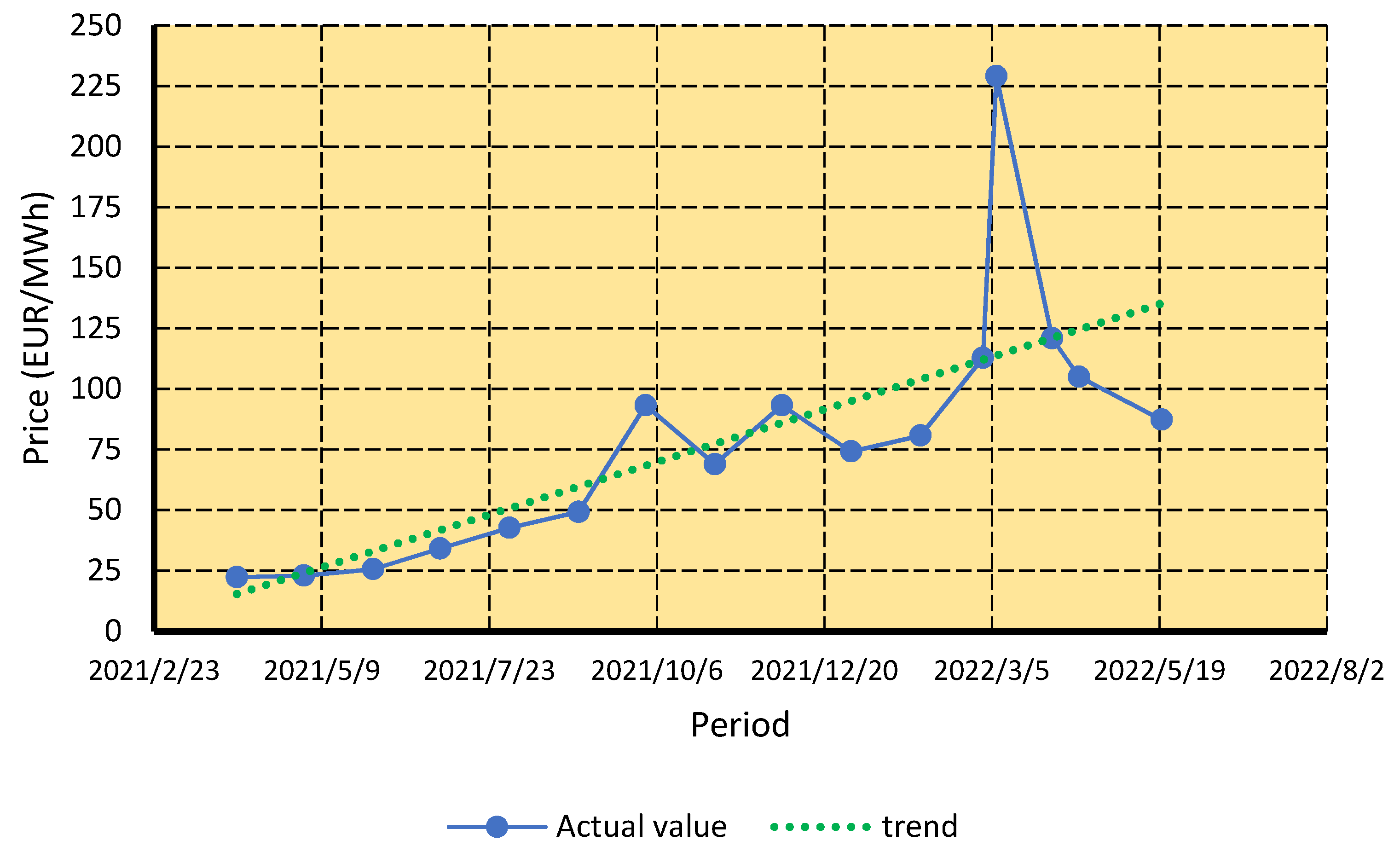
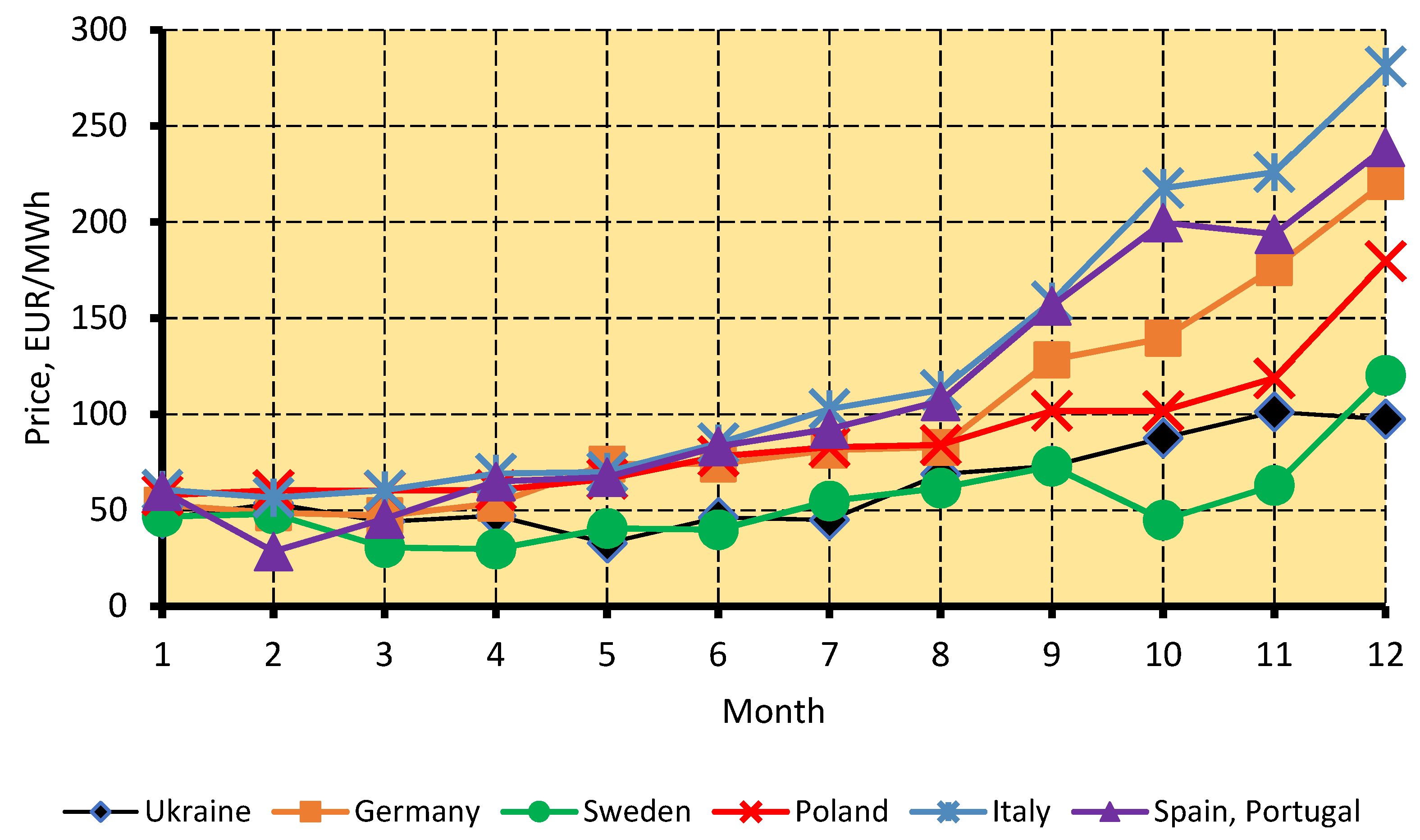
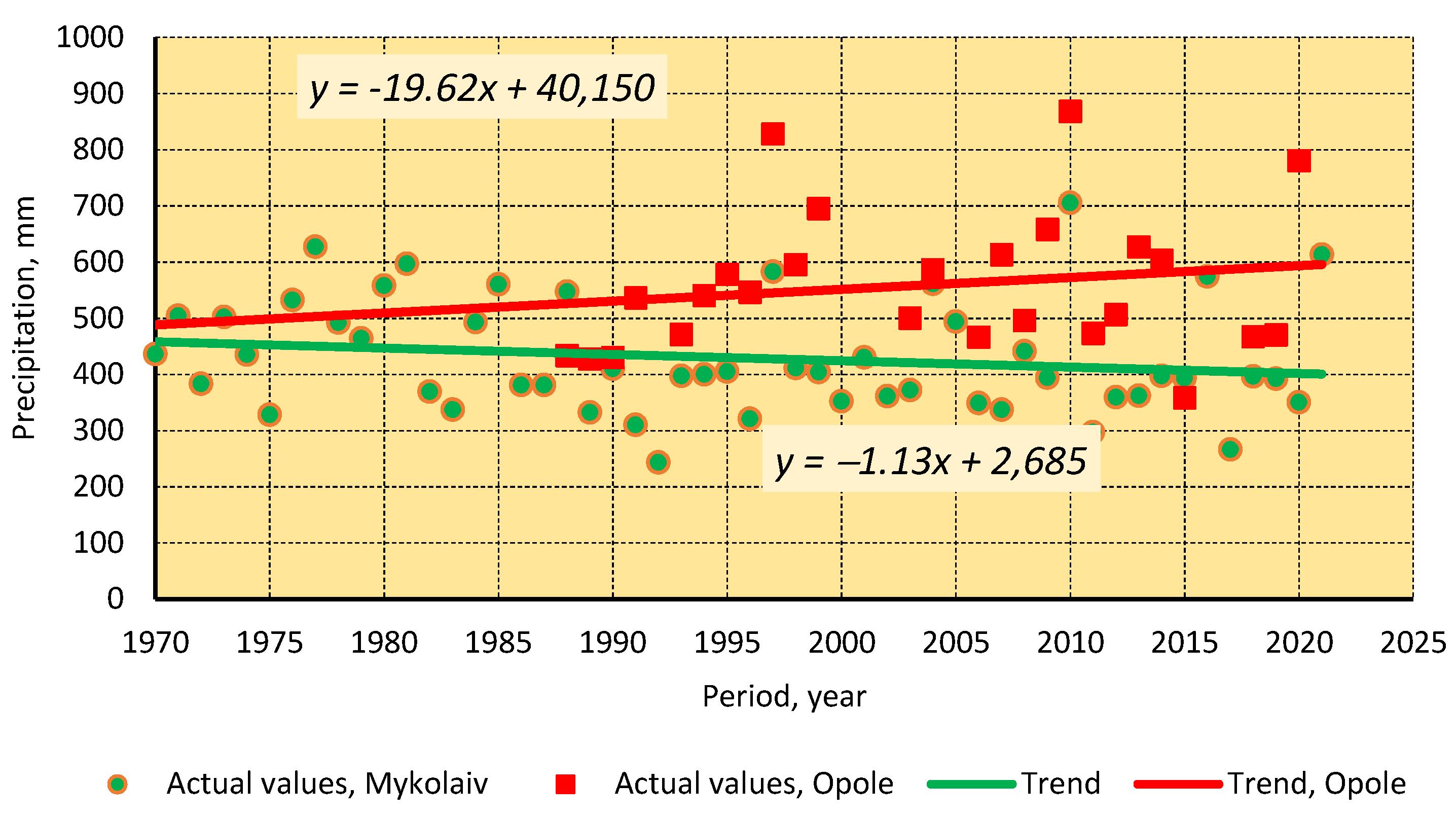
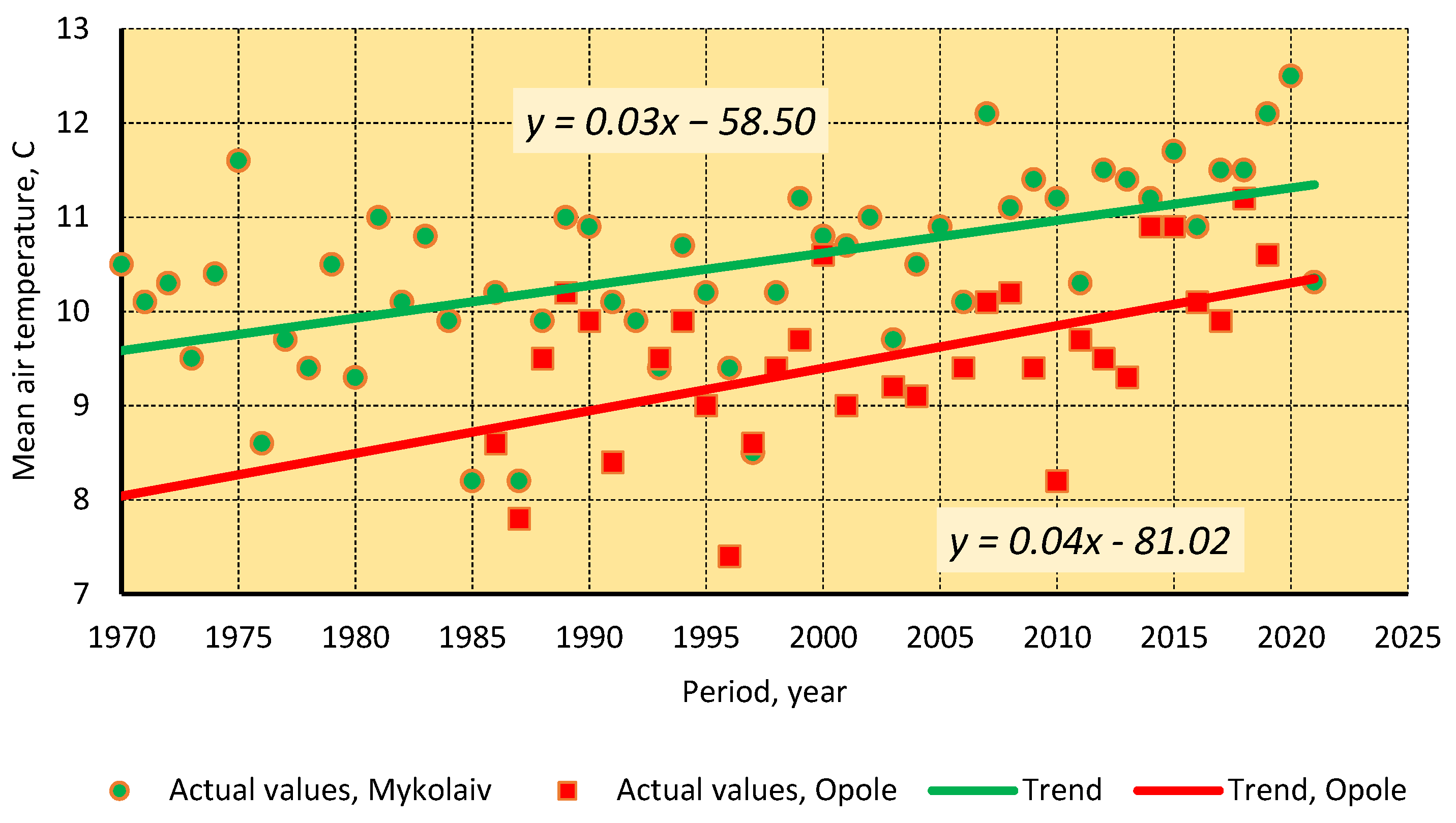
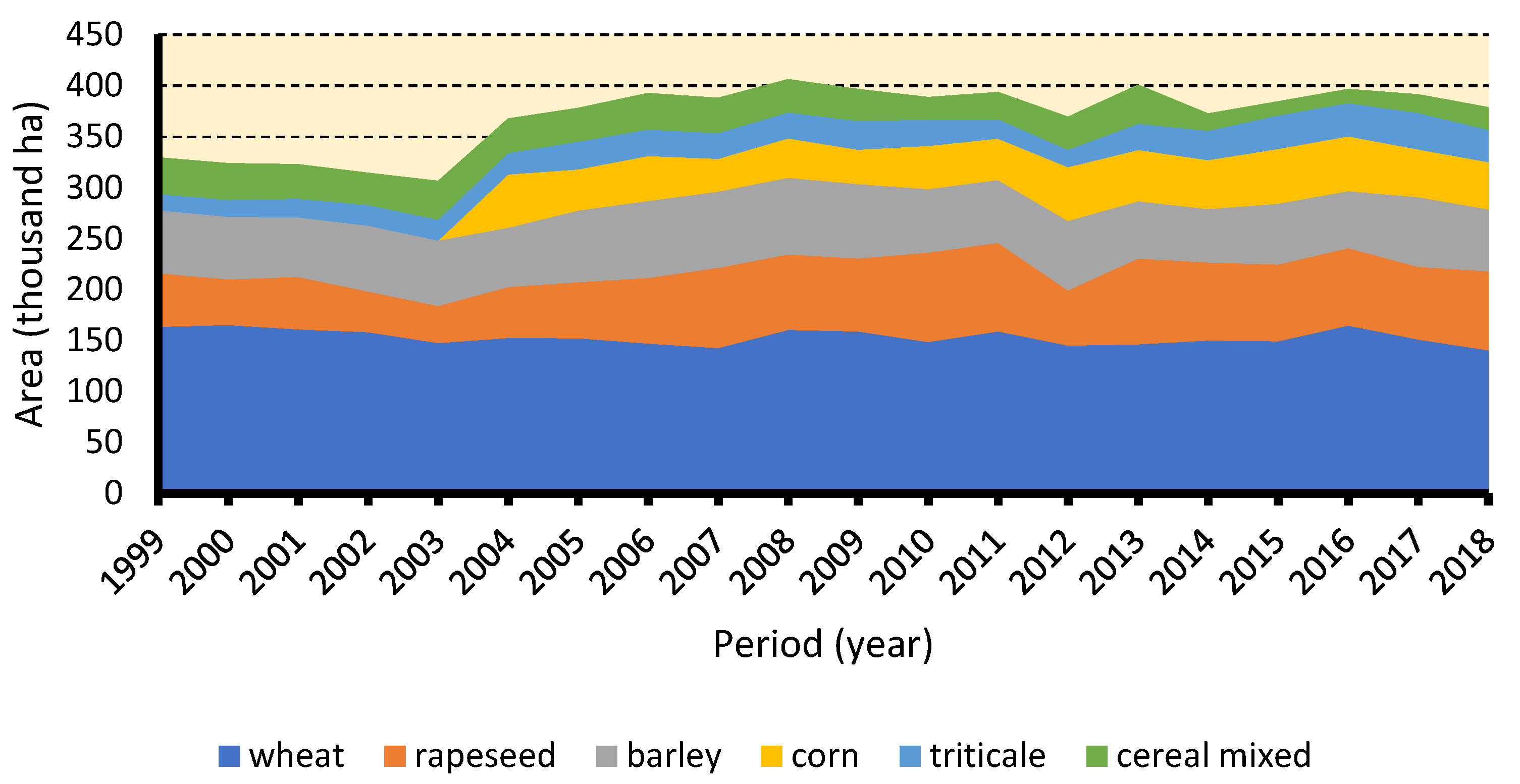
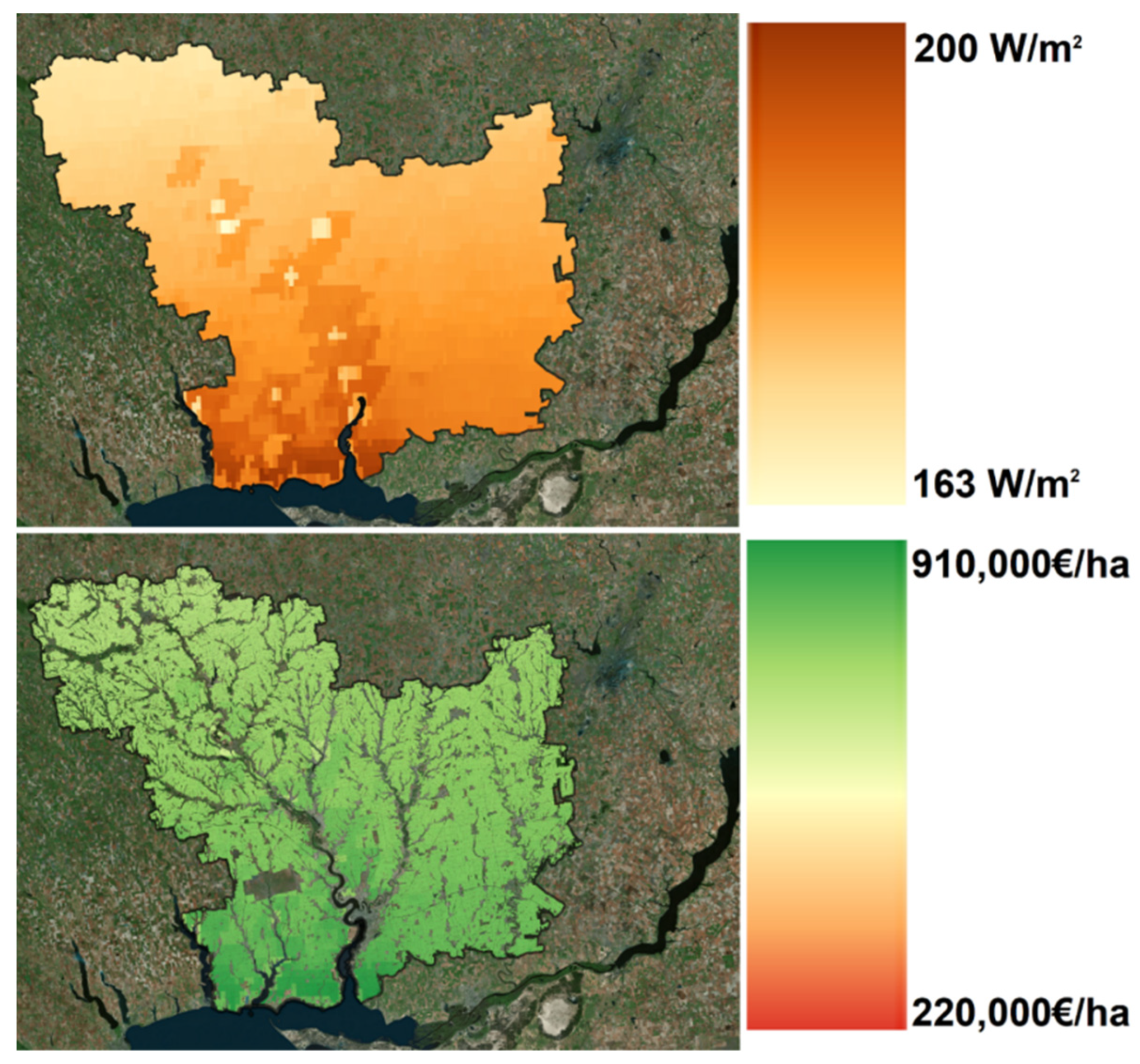
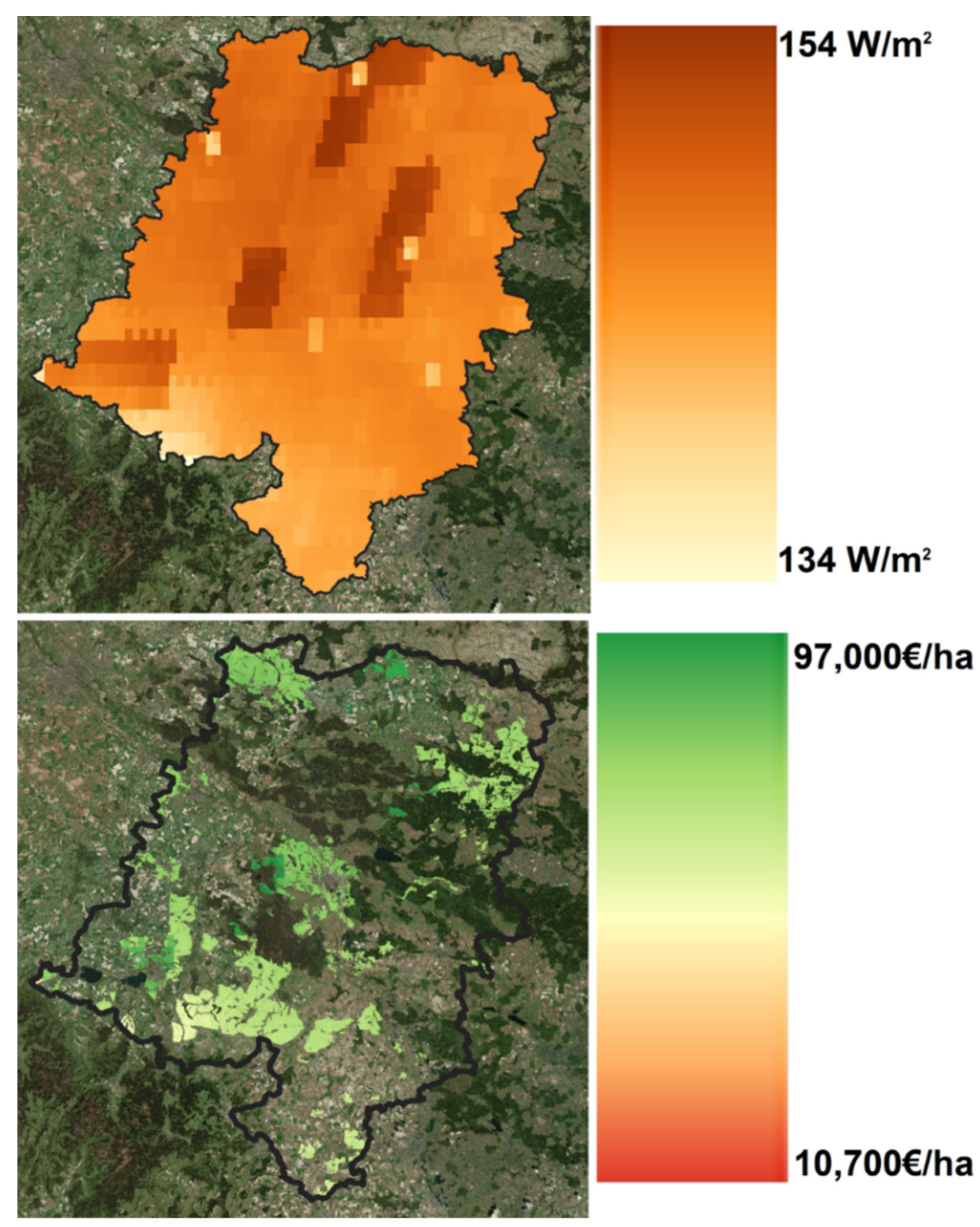
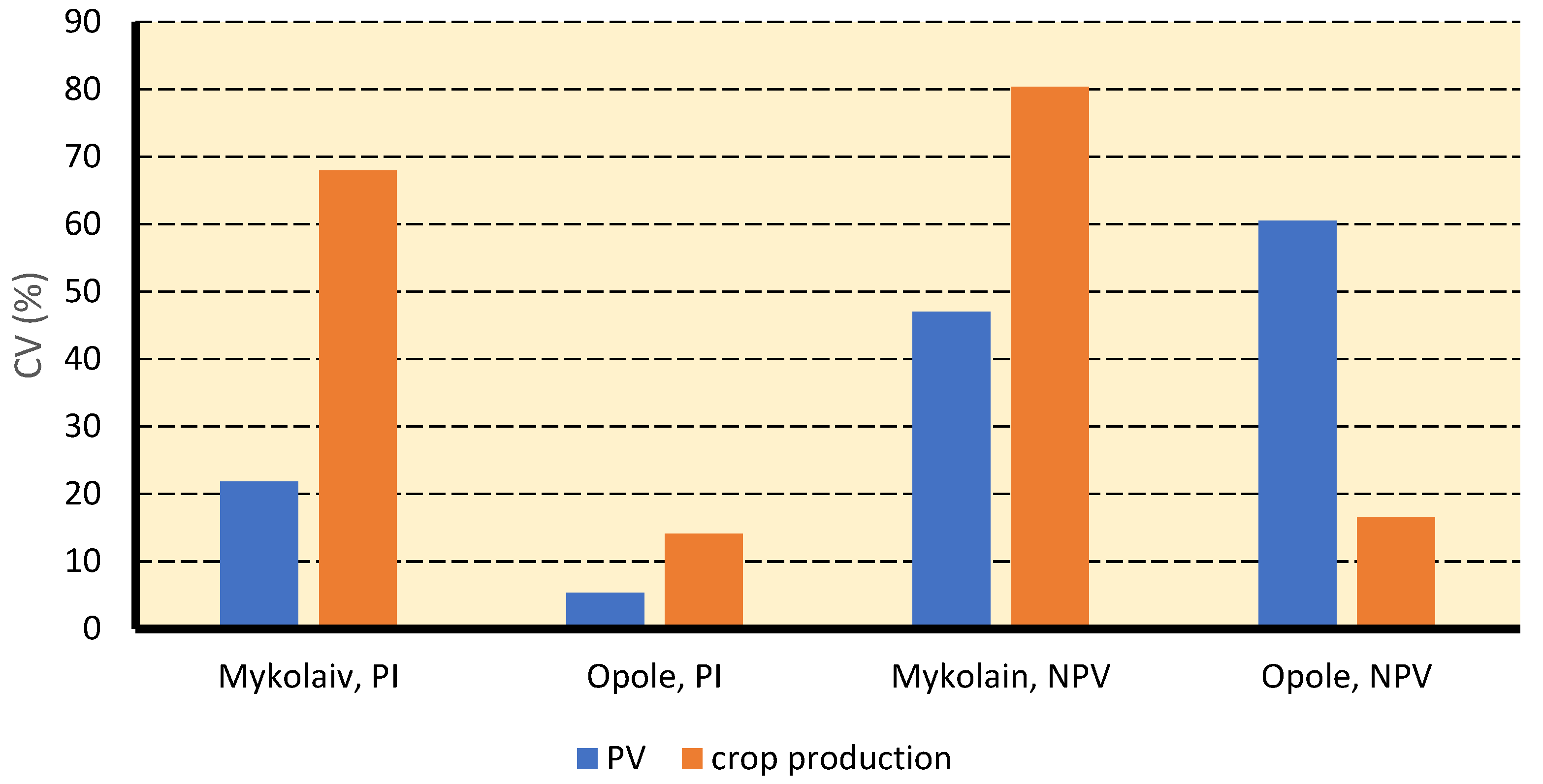
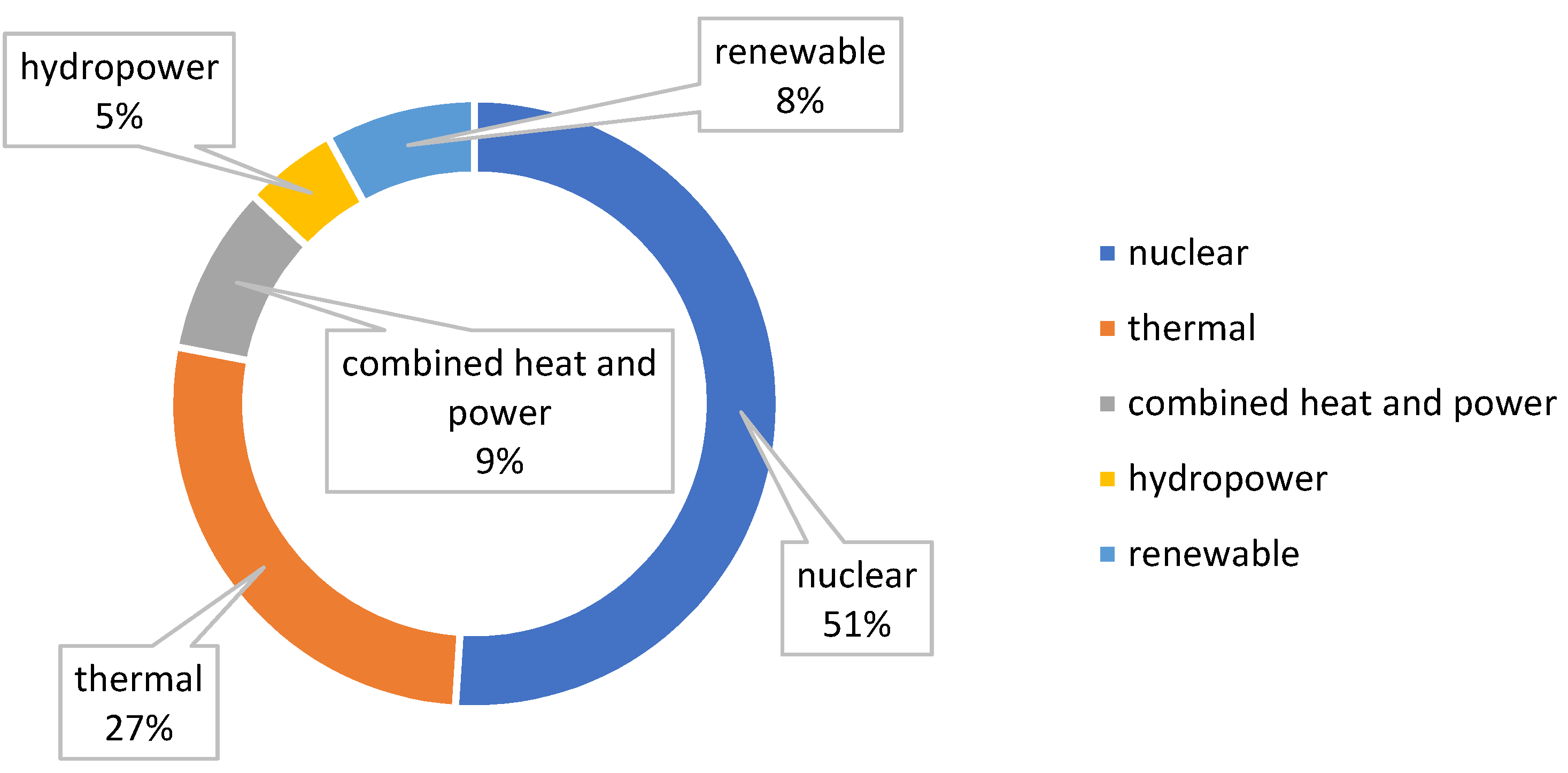
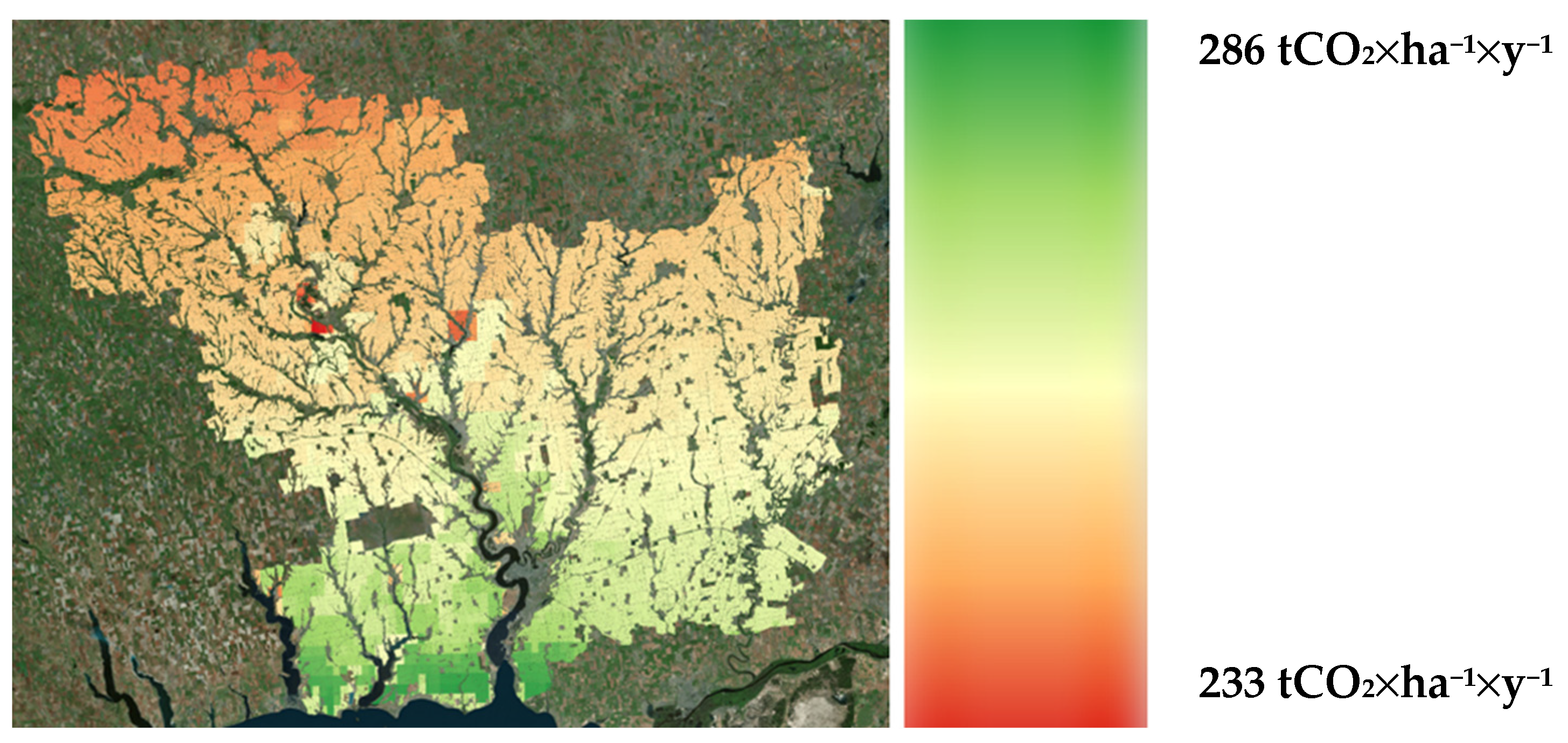
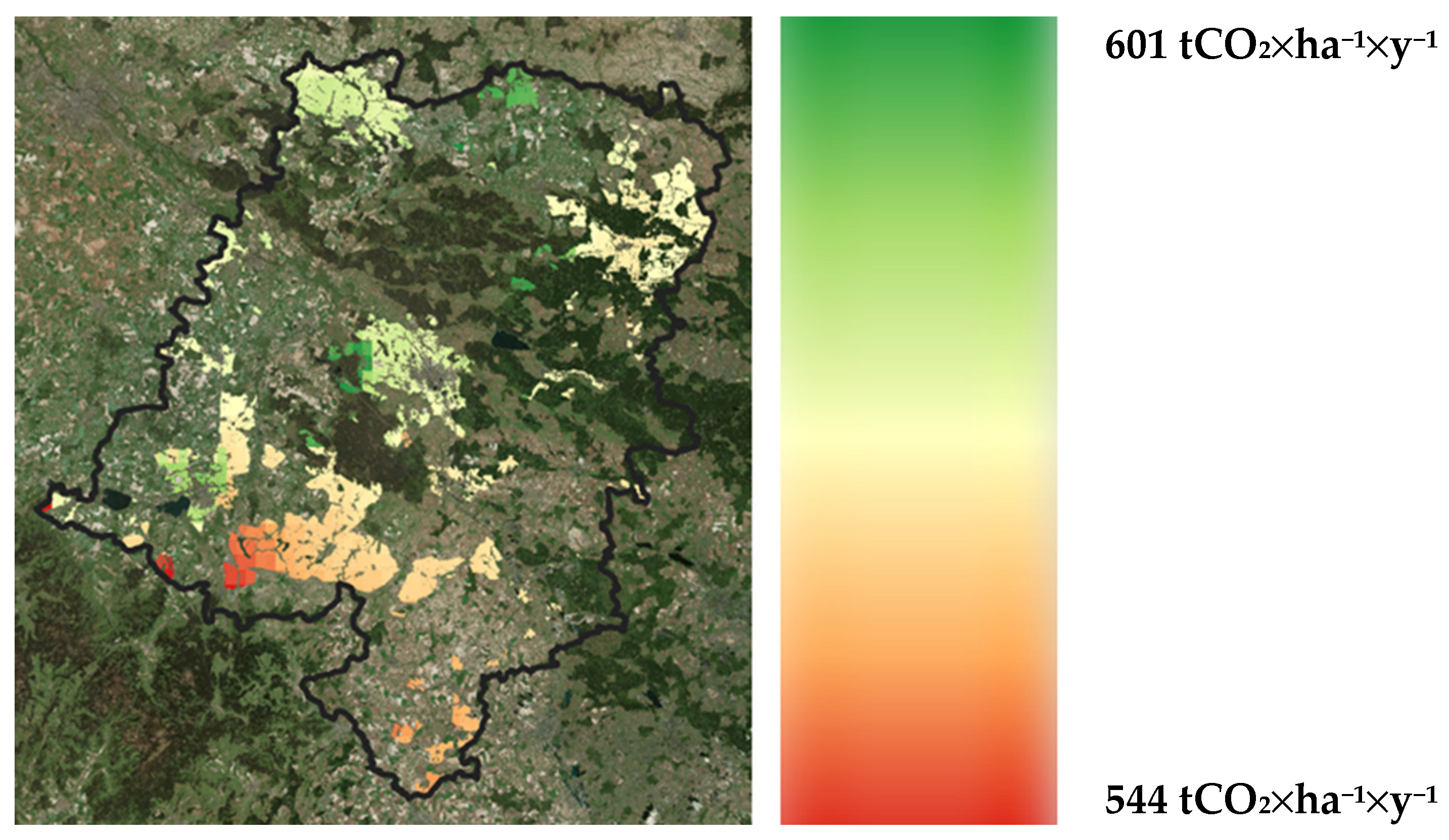
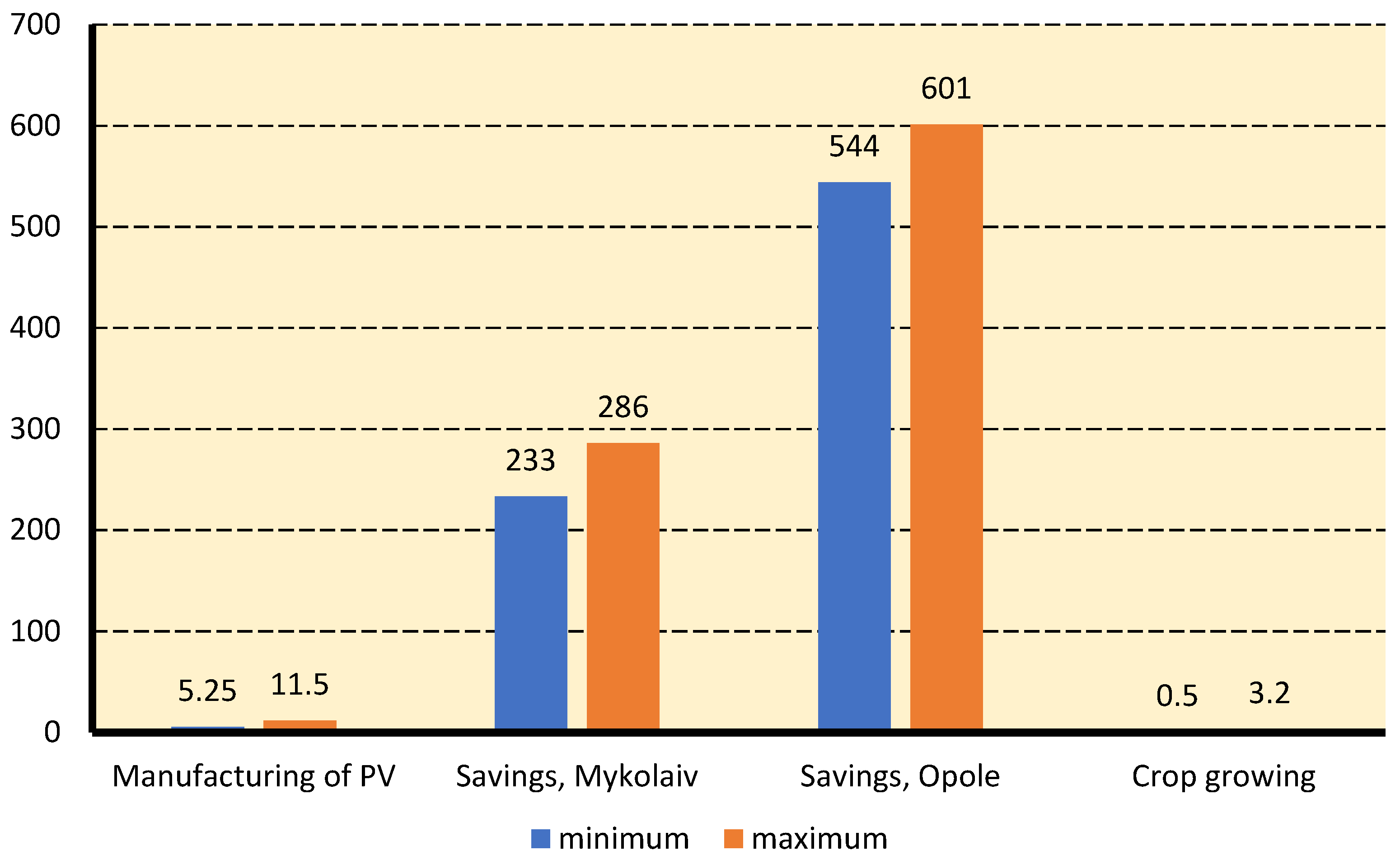
| Symbol (If Present) | Description | Unit | Value or Calculation |
|---|---|---|---|
| Resolution of raster maps | squared pixel, m | 100 | |
| Upper limit of slope | % | 20 | |
| Upper limit of altitude | m a.s.l. | 800 | |
| Hypothesised hours of sun per day | hour | 10 | |
| Hypothesised days of sun per year | day | 300 for Mykolaiv region; 280 for Opole region | |
| k | Net available surface for PV plants installation | % | 20 |
| η | PV plant efficiency | % | 75 |
| p | Price of PV power | EUR/MWh | 107 for Mykolaiv region; 57 for Opole region |
| inc | Additional optional incentives for PV energy | EUR/MWh | |
| r | Discount rate | % | 3 |
| d | Yearly decay of performance of photovoltaic modules | % | 1 |
| lc | Lifetime for PV plants | years | 20 |
| P | Installed PV power | MW/ha | 1 |
| u | Unit cost for fixed ground-mounted PV panels installation | EUR/MW | 1,180,000 |
| I | Purchase and installation cost | EUR/ha | I=P·u·k |
| g | Cost for PV plants connection to electric grid | EUR | Costs for the connection to the grid are differentiated according to the distance. In the absence of a regional dataset on geographic distribution of grid, a first approximation considered the distance (D) from i-th pixel to roads: 620 + (if D ≤ 200: EUR186; if 200 < D ≤ 700: EUR279; if 700 < D ≤ 1200: EUR836; if D > 1200: EUR1950). |
| R | Cost for rent of not irrigated arable land | EUR/(ha year) | 150 for the Mykolaiv region; 266 for the Opole region |
| m | Maintenance cost for PV plants | EUR/(ha year) | [61] |
| c | Cleaning cost for PV plants | EUR/(ha year) | [73] |
| a | Administrative and consultancies costs for PV plants | EUR/(ha year) | [73] |
| s | Insurance cost for PV plants | EUR/(ha year) | [73] |
| d | Decommissioning cost for PV plants | EUR/MW | 331,200 [58] |
| Specification | Unit | Mykolaiv Region | Opole Region |
|---|---|---|---|
| Sown area | thousand ha | 1699.7 | 466.8 |
| Agricultural land area per tractor | ha per unit | 265 | 14.9 |
| Average nominal tractor engine power | kW | 97.3 | 46.5 |
| Consumption of fertilizers | thousand tones | 171.7 | 98.2 |
| kg per ha | 101 | 210.4 | |
| Diesel fuel consumption | kg/ha | 57.59 | 161.57 |
| Crop | Mykolaiv Region | Opole Region | ||||
|---|---|---|---|---|---|---|
| Minimum | Maximum | Average | Minimum | Maximum | Average | |
| wheat | 1.64 | 4.20 | 3.08 | 4.20 | 6.57 | 5.34 |
| barley | 1.29 | 3.77 | 2.56 | 3.23 | 5.24 | 4.29 |
| corn | 2.49 | 5.17 | 3.91 | 4.24 | 9.39 | 7.07 |
| sunflower | 1.35 | 2.17 | 1.80 | - | - | - |
| rapeseed | 1.31 | 2.58 | 1.94 | 2.14 | 3.94 | 2.96 |
| triticale | - | - | - | 3.00 | 4.95 | 4.13 |
| cereal mixed | - | - | - | 2.94 | 4.05 | 3.48 |
| Machine | Number per 1000 ha | Costs, EUR/ha |
|---|---|---|
| tractor | 3.77 | 169.43 |
| combine harvester | 0.80 | 184.92 |
| truck | 3.12 | 82.68 |
| plough | 1.89 | 4.88 |
| cultivator | 2.69 | 22.10 |
| harrow | 6.98 | 33.63 |
| drill | 2.55 | 26.41 |
| machines for plant protection | 0.80 | 5.00 |
| fertilizer spreader | 0.84 | 2.31 |
| Total: | 531.35 |
| Indicator | Unit | PV | Crop Cultivation | PV to Crop Cultivation Ratio |
|---|---|---|---|---|
| Investment costs | thousand EUR/ha | 729.24 | 0.531 | 1373.3 |
| Lifetime | year | 20 | 8 | 2.5 |
| NPV | thousand EUR | |||
| 220.00 | 0.0476 | 4621.8 | |
| 910.00 | 7.111 | 127.9 | |
| 771.83 | 2.904 | 265.8 | |
| Profitability index | - | |||
| 1.302 | 1.090 | 1.19 | |
| 2.248 | 14.384 | 0.16 | |
| 2.057 | 6.465 | 0.32 |
| Indicator | Unit | PV | Crop Cultivation | PV to Crop Cultivation Ratio |
|---|---|---|---|---|
| Investment costs | thousand EUR/ha | 729.24 | 1.539 | |
| Lifetime | year | 20 | 20 | 1 |
| NPV | thousand EUR | |||
| 10.7 | 6.5 | 1.65 | |
| 97.0 | 9.8 | 9.89 | |
| 71.9 | 8.3 | 8.66 | |
| Profitability index | ||||
| 1.01 | 5.22 | 0.19 | |
| 1.13 | 7.39 | 0.15 | |
| 1.10 | 6.37 | 0.17 |
Publisher’s Note: MDPI stays neutral with regard to jurisdictional claims in published maps and institutional affiliations. |
© 2022 by the authors. Licensee MDPI, Basel, Switzerland. This article is an open access article distributed under the terms and conditions of the Creative Commons Attribution (CC BY) license (https://creativecommons.org/licenses/by/4.0/).
Share and Cite
Sacchelli, S.; Havrysh, V.; Kalinichenko, A.; Suszanowicz, D. Ground-Mounted Photovoltaic and Crop Cultivation: A Comparative Analysis. Sustainability 2022, 14, 8607. https://doi.org/10.3390/su14148607
Sacchelli S, Havrysh V, Kalinichenko A, Suszanowicz D. Ground-Mounted Photovoltaic and Crop Cultivation: A Comparative Analysis. Sustainability. 2022; 14(14):8607. https://doi.org/10.3390/su14148607
Chicago/Turabian StyleSacchelli, Sandro, Valerii Havrysh, Antonina Kalinichenko, and Dariusz Suszanowicz. 2022. "Ground-Mounted Photovoltaic and Crop Cultivation: A Comparative Analysis" Sustainability 14, no. 14: 8607. https://doi.org/10.3390/su14148607
APA StyleSacchelli, S., Havrysh, V., Kalinichenko, A., & Suszanowicz, D. (2022). Ground-Mounted Photovoltaic and Crop Cultivation: A Comparative Analysis. Sustainability, 14(14), 8607. https://doi.org/10.3390/su14148607









